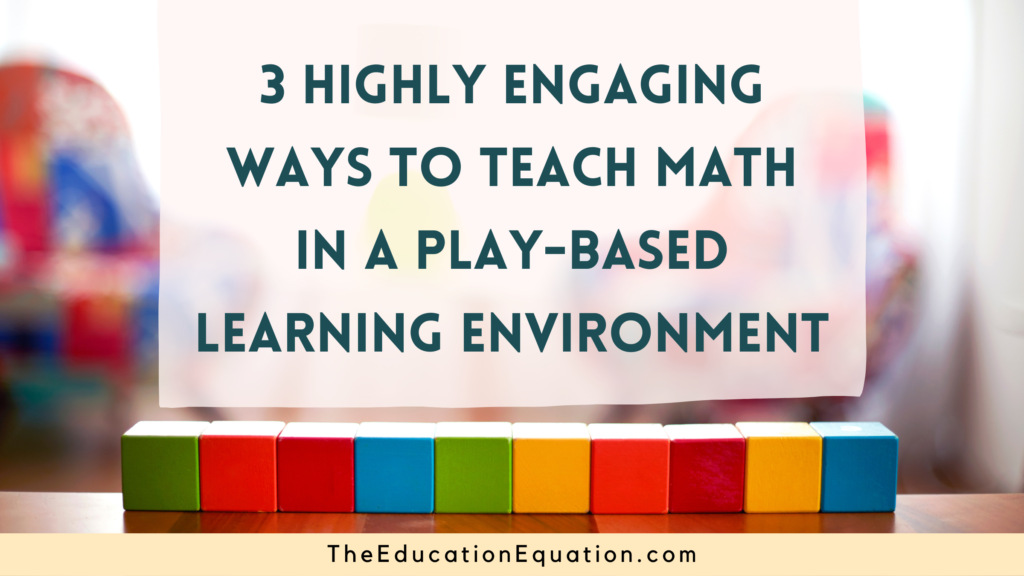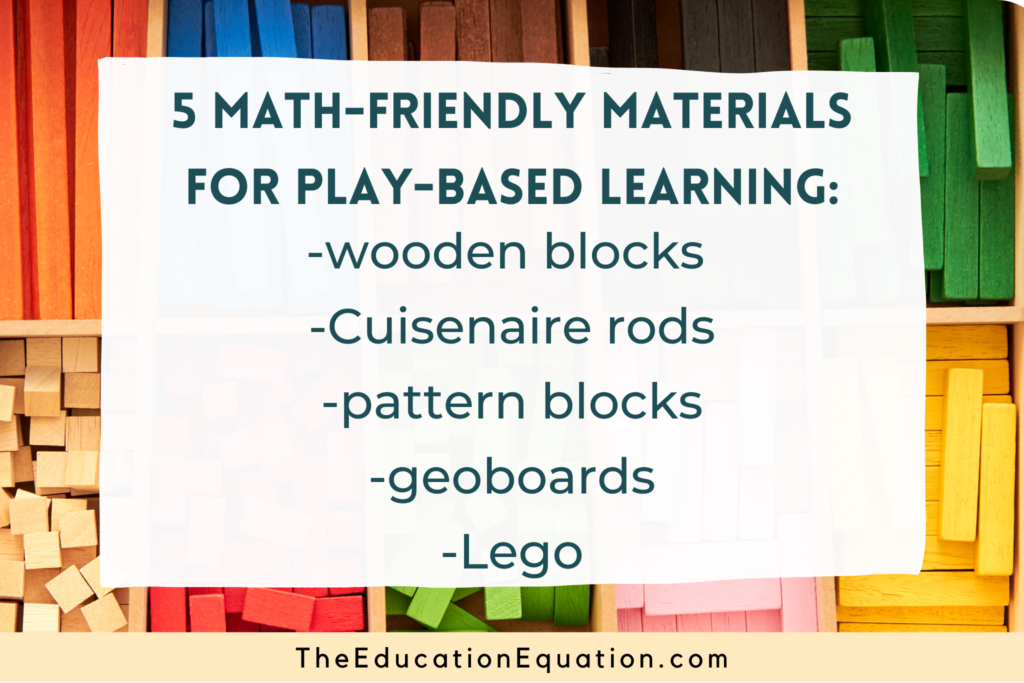If your kindergarten students are anything like mine, they LOVE TO PLAY! (I mean, who doesn’t love playing?). Play-based learning environments build on this love of play and children’s natural curiosity. As teachers, we can use these everyday experiences to foster early math skills and the learning of math concepts such as shapes, size, numbers, sorting, patterning, data management, and more. And the best part is, kids are learning by doing what they love most – playing!

What is play-based learning?
So what is play-based learning anyways? Play-based learning is exactly what it sounds like – learning through play. This play can be 100% child-led, open-ended free play. It can also include the teacher meeting the child where they are at in their play to extend or introduce academic concepts. Play-based learning can also look like games and activities with intentional outcomes planned by the teacher.
If you want to learn more about play-based learning in kindergarten, I recommend reading this article: Defining Play-based Learning (Erica Danniels, MEd, Angela Pyle, PhD
OISE University of Toronto, Canada, February 2018)
Benefits of Play-Based Learning

3 ways I use play-based learning to teach math in kindergarten:
Here are 3 ways I use play-based learning to engage my students and promote playing with math as a part of their everyday routine:
1. Include math manipulatives for kindergarten in the play-based learning environment.
In my kindergarten classroom, the students get to choose which activities they want to play with during our free play blocks. While giving a class full of 4 and 5-year-olds free reign might sound like mayhem in the making, rest assured, my teaching partner and I have it under control (well, most days!). With our learning goals in minds, we decide which activities students can choose from. Additionally, expectations are clearly established with our students along with reminders to help our littles manage all this freedom!
By intentionally creating a learning environment that includes opportunities for child-led play with math-friendly materials, our students get the chance to explore a variety of math concepts on their own terms. This can look like seeing how tall they can build a tower with blocks or creating a symmetrical design with pattern blocks. It might look like kids creating and exploring these materials in non-mathematical ways. When the play-based learning environment includes math manipulatives for kindergarten, students are free to explore, make observations, draw conclusions, solve problems, and wonder about these materials.

2. Be on the lookout for students playing with math!
So now that we have set up our play-based learning environment to include math-friendly materials, next we need to look and listen for students playing with math. Just think of yourself as a friendly, kindergarten teacher spy, out to catch your students in the act of playing with math. Tricky, I know, but what better way to introduce math concepts and vocabulary to young learners than by meeting them where they are already at in their play? I find this to be one of the most authentic, effective, real-life ways to explore math with kindergarteners in a play-based environment.
HINT: Get to know your math curriculum! Knowing your kindergarten math curriculum will help guide you in what you are looking for and what direction you want to go in with the math.
Here is an example of how easy it can be to transform child-led play into learning math through play:
My kiddos love playing with PlayDoh! They also love making me food to ‘eat’. Now while I do get the occasional PlayDoh ice cream cone, my kiddos recently went through a French fry making phase. This type of child-led, dramatic play provides the perfect backdrop for me to sprinkle in some math. By asking questions to prompt mathematical thinking, I am able to introduce math as a part of the play.
Here are some prompts I used to extend child-led play into playing with math.
“How many fries did you make for me?”
“How many fries should I eat?”
“If I eat one fry, how many are left?”
“Let’s share the fries. How many do you have? How many do I have? Do we have the same amount? Who has more?”
“You made 6 fries, but I’m really hungry. Can you make me 4 more fries? How many fries do I have now?”
It is important to note that questions like these are invitations to extend learning. If a child does not want to accept my invitation, I usually let it go. What I do instead is make a note that I will need to pull the student aside to explore similar math concepts at a different time and in a different way. In my experience though, I do find that most students will accept these invitations. In fact, it is common to also have other students nearby that will want to join in. Before I know it, I’m surrounded by PlayDoh French fries and kids counting.
3. Use playful math games as a way to reinforce mathematical concepts
Another good way to teach mathematical concepts is by adding ready to go, engaging math games and activities into your playful math mix. Your students will enjoy playing these games and learning new skills at the same time. Bonus points if the activity includes movement!
Here are a few playful math games and activities that are always a hit in my kindergarten classroom:
Count the Room
Count the Room gets students up and moving around the classroom while practicing skills like printing numbers, subitizing, and counting. My kids love the chance to be active as they work on numbers. I love being able to make quick observations of my student’s math skills. I am able to see who needs some individual or small group practice with counting, who needs help printing numbers, and who is ready for something more challenging.
Roll & Cover
Roll and Cover is definitely a favourite with my kindergarten students (and I suspect the dice rolling has something to do with it. I mean have you ever met a kindergarten student that doesn’t get excited about rolling a dice?). Once the students roll the dice and count or subitize the number, they find the corresponding number on the number mat. They keep repeating this until all the numbers are covered.
BONUS POINTS: If you can find giant dice at your local dollar store your students will love this activity even more.
CLASSROOM MANAGEMENT TIP: Remember to start with clear expectations and boundaries with your kiddos. This will help you avoid a pack of littles kicking the dice around the room like a soccer ball. Don’t worry though, If they can’t handle the excitement of rolling a dice, a spinner works just as well
BINGO
Bingo is a tried and true, old school classic game that kids from kindergarten and up always seem to get excited to play. Even I remember loving this game as a child. In my kindergarten class we play a range of math Bingo games for identifying numbers, coins, and shapes. Bingo games for math are always a fun way for students to practice their math skills and celebrate their learning.
How will you include more play-based learning opportunities for teaching math in your classroom?
And there you have it – three effective strategies for teaching math to kindergarten students in a play-based learning environment.
Have you tried any of these strategies in your classroom? Remember, take the time to set up your room for success, but don’t get stuck – messy action is better than no action at all, and with play-based learning sometimes you just need to take the leap and have some fun with it (I know I’ve been there!).
If you want to know more about planning out play-based math activities in your classroom, I also love sharing my teaching ideas on Instagram! Follow me here to see what I’m doing in kindergarten and for tips on teaching math from k-6…and DON’T BE SHY! Send me a DM or comment on a post so I can say hi!





